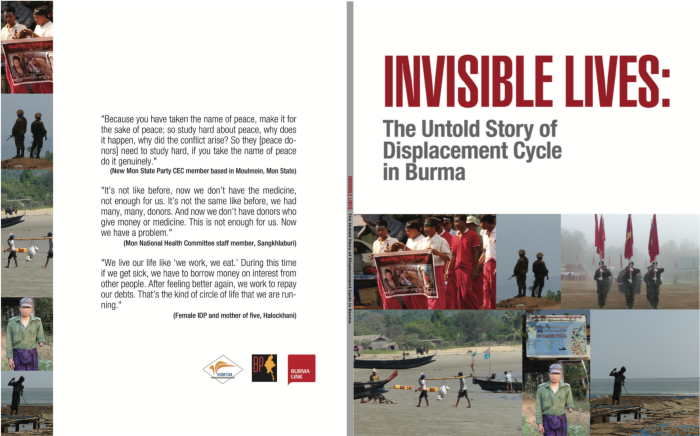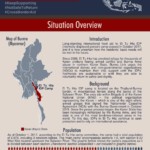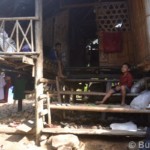Burma Partnership | August 16, 2016
This past week three civil society organizations, Human Rights Foundation of Monland, Burma Link and Burma Partnership released a joint report, titled Invisible Lives: The Untold Story of Displacement in Burma, underlying the ongoing challenges facing displaced ethnic communities. The report highlights the case of Mon refugees who were repatriated from Thailand in 1994 only to remain as internally displaced persons (IDPs) for the last twenty years. In doing so, Invisible Lives exposes the factors that led to displacement, along with the obstacles facing IDPs upon their return to Burma. These findings may be applied not only to Mon refugees but also to the rest of Burma’s 644,000 displaced individuals, including the approximately 100,000 refugees living along the Thailand-Burma border.
According to the report, the roots of Mon IDPs traces back to early conflict beginning in 1948, as Mon ethnic armed organizations (EAOs) fought for self-determination and ethnic equality. The following years, through periods of intense military campaigns by the Burma Army against the Mon EAOs, eventually resulted in the displacement of between 10,000 and 12,000 ethnic Mon civilians into Thailand in 1990. Unfortunately, this did not offer any respite for the Mon refugees, who were eventually forced back into Burma despite not having any guarantee that they would be free from violence or persecution.
To this day, returned Mon refugees continue to face serious challenges at IDP sites in Burma, including the inability to maintain a sustainable livelihood, food insecurity, and limited access to healthcare. In addition, Invisible Lives has documented the decreasing humanitarian aid available to Mon IDPs, a trend that has been observed throughout Burma’s ethnic border regions as international aid priorities have shifted to inside the country as a result of the country’s recent economic and political transitions.
A number of Mon IDPs interviewed for Invisible Lives expressed concern over their personal security when considering their return to their place of origin as “border-trade, land disputes and natural resource extraction have the potential of renewing outbreaks of armed conflict in the southeast.” Despite a ceasefire in place, numerous interviewees spoke of the fragility of the peace process and questioned how they might be protected in the event of renewed conflict. This concern is not limited to just the ethnic Mon – the lack of genuine political will from successive Burma Governments and military regimes to address the root causes of conflict in ethnic regions has led to numerous international and domestic human rights advocates, including the Special Rapporteur on the situation of human rights in Burma, Yanghee Lee to question how Burma’s current peace process is going to achieve sustainable peace. Failure to address these root causes will only further complicate the already complex lead-up process to the 21st Century Panglong Conference.
Finally, returning refugees must also contend with limited land ownership rights, which have long contributed to limited land security and further displacement. This feeling was best characterized by Khu Oo Reh, General-Secretary of the United Nationalities Federal Council, who recently responded to a statement by Daw Aung San Suu Kyi, during their meeting in which the state counselor asked political stakeholders to think about how they can “give” as oppose to “take” during the upcoming peace process. In contrast, Khu Oo Reh highlighted how historically, successive Burma Governments and military regimes have continually exploited ethnic areas, stating, “Go and look at the non-Bamar ethnic states. Mountains have turned flattened, flat lands (plains) become desert, river, stream and ponds dried. Our villages were being destroyed and our population have fled to jungles and mountains. Our mineral resources have been depleted and no trees and bamboos (forest) exist anymore. Now, what do you want more from us? What should we give more?”
Invisible Lives has illuminated a number of factors that should be seriously considered by the new NLD-led Government with genuine political will ahead of the upcoming 21st Century Panglong conference. If the peace process is to be a success, all stakeholders must take the time to examine the factors that underscore the tensions between non-Burman ethnic nationalities groups, the Burma Army, and the Burma Government. All parties involved in the peace process, including international peace donors, must also recognize the dire conditions facing IDPs in Burma, namely to help provide sustainable livelihoods for conflict-affected displaced ethnic populations. Finally, any talk of repatriation must be inclusive with meaningful consultation and participation of refugees and IDPs themselves and potential local hosts, as well as ethnic community-based organizations, to ensure that their concerns are addressed adequately and effectively for long term sustainable solutions. This should also include special attention to international instruments such as the UN’s Principles on Housing, Land and Property Rights for Refugees and Displaced Persons (also known as the ‘Pinheiro Principles’) and other best practices.
This article originally appeared on Burma Partnership on August 16, 2016.


![‘The Burma Army Killed Him [Saw O Moo] – At Least the Government or the Army Should Commit to Not Do This Again’: Paul Sein Twa, Executive Director of KESAN](https://www.burmalink.org/wp-content/uploads/2018/05/Saw-O-Moo-commemoration-Paul-Sein-Twa-speaking-2-150x150.jpg)


![‘It Is Dangerous for Our People or Any Organization to Move There [Burma]’: Khu Myar Reh, Karenni Refugee School Principal](https://www.burmalink.org/wp-content/uploads/2018/06/Khu-Myar-Reh-Karenni-Refugee-Principal-150x150.jpg)

